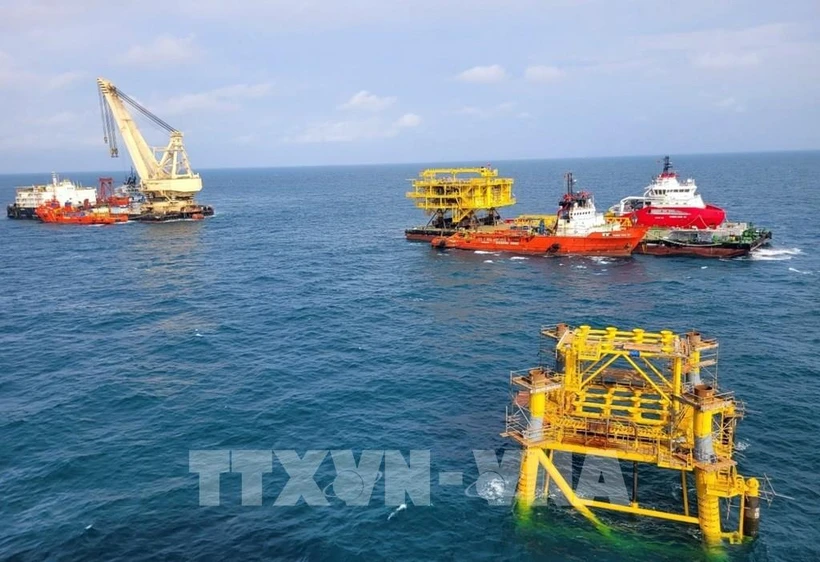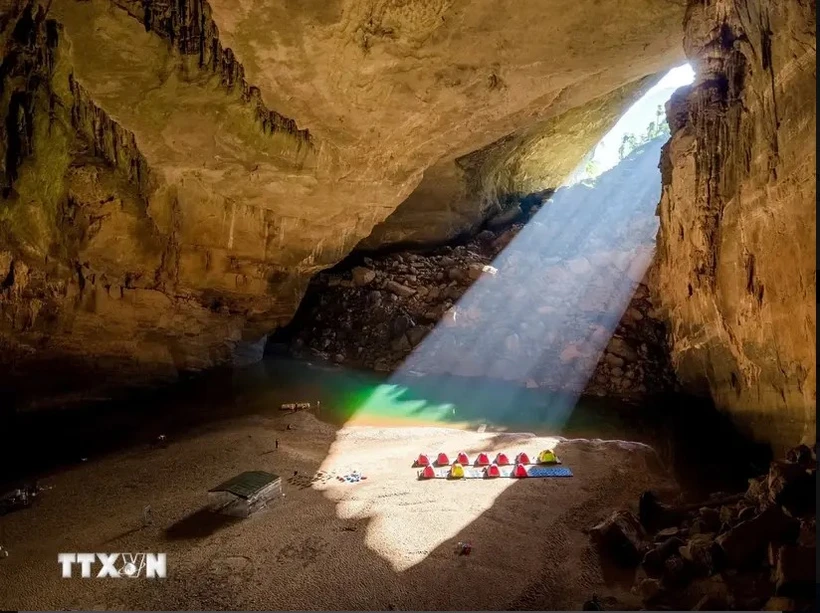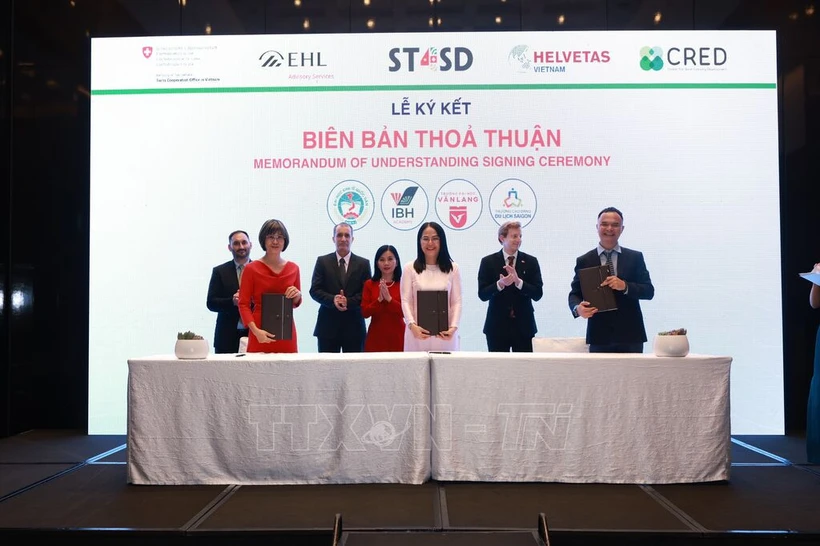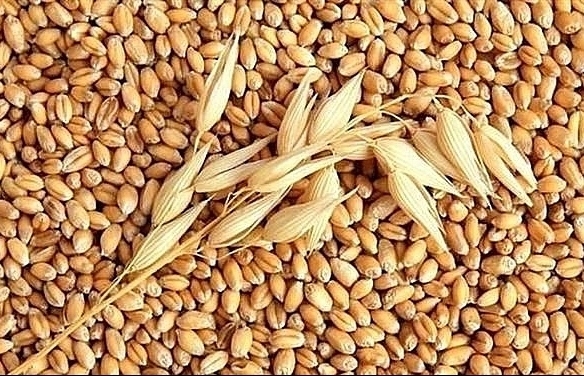 |
| The wellhead platform topside block of the BK-23 drilling rig at Lot 09.1 of Bach Ho oil field is successfully installed on September 10. (Photo: VNA) |
More than 130 workers used a crane vessel to install the 760-tonne block in accordance with schedule, ensuring safety and the most rational costs despite bad weather conditions caused by typhoon Yagi.
BK-23, an unmanned wellhead platform, is located near the existing BK-14 oil rig, which will receive oil and gas from the former through an auxiliary equipment system and connecting pipelines.
Environmental protection crucial in cave tourism activities: Experts
 |
| Inside Son Doong cave in the central province of Quang Binh, the largest cave in the world. (Photo: VNA) |
The exploitation of cave tourism must follow certain principles to ensure sustainable and safe development as well as high efficiency, experts said at a conference held in Hanoi on September 10, reported Vietnam News Agency.
Vietnam owns a valuable system of natural caves, with Son Doong in the central province of Quang Binh considered to be the largest cave in the world, and En cave known as the third biggest cave with white sand and a river inside.
Many cave systems in Vietnam are not only majestic natural wonders, but also contain historical and cultural values because they were once inhabited by prehistoric people or are related to local folk tales and legends.
Nguyen Hoang Mai from the Institute for Tourism Development Research said that in Vietnam, cave tourism is closely linked to the orientation of sustainable tourism development with the balance in the three pillars of economy - culture and society - environment.
Mai underlined that cave tourism is relating to many other types of tourism such as nature-based tourism, eco-tourism, community, cultural-historical, spiritual, archaeological, adventurous, and geological tourism.
Doan The Anh, Vice Director of the Vietnam Centre on Karst and Geoheritage under the Vietnam Institute of Geosciences and Mineral Resources, cited surveys by many foreign expert delegations over the past 30 years showing that caves in Vietnam are mainly formed from limestones and from volcanic activity.
However, Nguyen Anh Duc from Oxalis Adventure held that although Vietnam own many valuable cave systems, the country has yet to show a balance between tourism development and natural conservation. Particularly, environmental pollution and waste problems have prevented cave tourism from developing to its full potential, he stated.
According to the Institute for Tourism Development Research, cave tourism is a sensitive type of tourism that can easily pose negative impacts on resource values, especially natural tourism resources.
Experts held that it is crucial to preserve nature, biodiversity and cave environment, ensuring the benefits and sustainable development of local communities, conserving and promoting cultural and historical values associated with caves, protecting safety during management and operation, and ensuring safety for visitors in tourism activities.
In order to make full use of cave values and promote tourism, localities and tourism service providers should focus on training people engaging in tourism service provision on issues relating to cave safety, while guiding visitors on natural protection, raising public awareness of cave environment protection, they said.
Compliance with the guidelines will help protect and promote the value of the caves, while bringing long-term economic benefits to the local communities, they stressed.
Switzerland supports Vietnam in tourism human resources training
 |
| The signing ceremony of memorandum of understanding on training cooperation (Photo: VNA) |
Helvetas Swiss Intercooperation, a Swiss association for international cooperation, in collaboration with Vietnam’s Centre for Rural Economy Development (CRED), on September 10 launched the Swiss Executive Hospitality Training (Swiss EHT) programme, as part of the Swiss Tourism for Sustainable Development project in Vietnam” (ST4SD) project, reported Vietnam News Agency.
The programme aims to develop the Vietnamese tourism industry in general and high-quality human resources in the tourism and hospitality sector in particular in a more sustainable and comprehensive manner.
Training programmes under the ST4SD project to improve the quality of human resources in the Vietnamese tourism industry will comply with many international standards. The training courses, programmes and conditions are built under close cooperation between Vietnamese training institutions and the EHL Hospitality Business School of Switzerland. In the pilot period from 2023-2027, the project is being carried out in four training institutions in Hanoi, Da Nang and Ho Chi Minh City.
Dang Thi Phuong Anh, who manages the project’s human resources quality improvement component, said that to date, 17 lecturers at these training institutions have participated in skills training in accordance with international standards, under the guidance of Swiss experts. They have been certified and become trainers of the Swiss EHT programme. In the fourth quarter of 2024, the four institutions are expected to launch the first training courses with 15-20 students a class.
Ngo Thi Quynh Xuan, Principal of Saigon Tourism College – one of the four training institution, said that improving the quality of human resources is a long-term and sustainable direction for tourism development. When Vietnamese tourism personnel meet international standards, they will better meet the expectations of employers, as well as the job requirements of tourism service businesses.
The support from the Swiss side will help domestic tourism human resources reach higher international standards, thus meeting the needs of domestic and foreign labour markets, she added.
Vietnam spends over US$1 billion importing wheat in eight months
Vietnam spent more than US$1 billion importing approximately 3.64 million tonnes of wheat during the eight-month period, marking a sharp increase of 18.3% in volume but a fall of 6.7% in value, VOV News quoted statistics of the General Department of Vietnam Customs.
 |
| Photo for illustration. (Source: VOV) |
Insiders attributed the rise in wheat imports to the fall occurring in terms of the average import price of wheat by 21.2% on-year.
With regards to import markets, Brazil, Australia, Ukraine, the United States, and Canada were all among the largest wheat suppliers to the Vietnamese market during the seven-month period.
The import volume of wheat increased sharply by 348.9% compared to the same period from last year, while import value also skyrocketed by nearly 205.9%.
Most notably, import volume from Ukraine to the Vietnamese market rose dramatically with volume reaching 612,800 tonnes, worth up to US$159.4 million. Ukraine surpassed the US and Canada to become the third largest supplier of wheat to Vietnam throughout the reviewed period.
Vietnam is currently one of the 10 largest wheat importers in the world. Last year saw the country spend up to US$1.9 billion to import about 5.5 million tonnes of wheat.
The import demand for wheat is attributable to the growing demand for wheat domestically, especially for the animal feed and food processing industries.
Vietnam emerges as largest importer of cashew nuts from Cambodia
Vietnam was the largest importer of cashew nuts from Cambodia with import volume reaching 786,530 tonnes worth roughly US$1 billion, accounting for nearly 95% of Cambodia's raw cashew output during the seven-month period, VOV News quoted statistics of the General Department of Vietnam Customs.
 |
| Photo for illustration. (Source: VOV) |
These figures marked a sharp increase of 34.1% in volume and 26.3% in value compared to the same period from last year.
The proportion of Cambodian cashew nuts accounted for 47.2% of Vietnam’s total cashew nut import turnover, an increase of 9.6 percentage points compared to the same period from last year.
At present, Vietnam is the world's leading country in terms of cashew production and exports. The nation exported approximately 478,000 tonnes of cashew nuts worth US$2.77 billion during the eight-month period, a rise of 22.9% in volume and 21.7% in value on-year.
The country has mainly relied on imported raw cashews for cashew processing and production, including a large amount of cashew from neighbouring Cambodia.
In recent years, along with Africa, Cambodia has also advocated the development of domestic processing industry by gradually reducing raw exports.
The Vietnam Cashew Association has therefore advised local firms to ensure raw material supply sources in a bid to maintain the country’s position as the world’s leading cashew exporter.
Insiders pointed out that amid difficulties in increasing the cultivation area, Vietnamese cashew enterprises are required to co-operate and develop cashew material areas in Cambodia and southern Laos./.